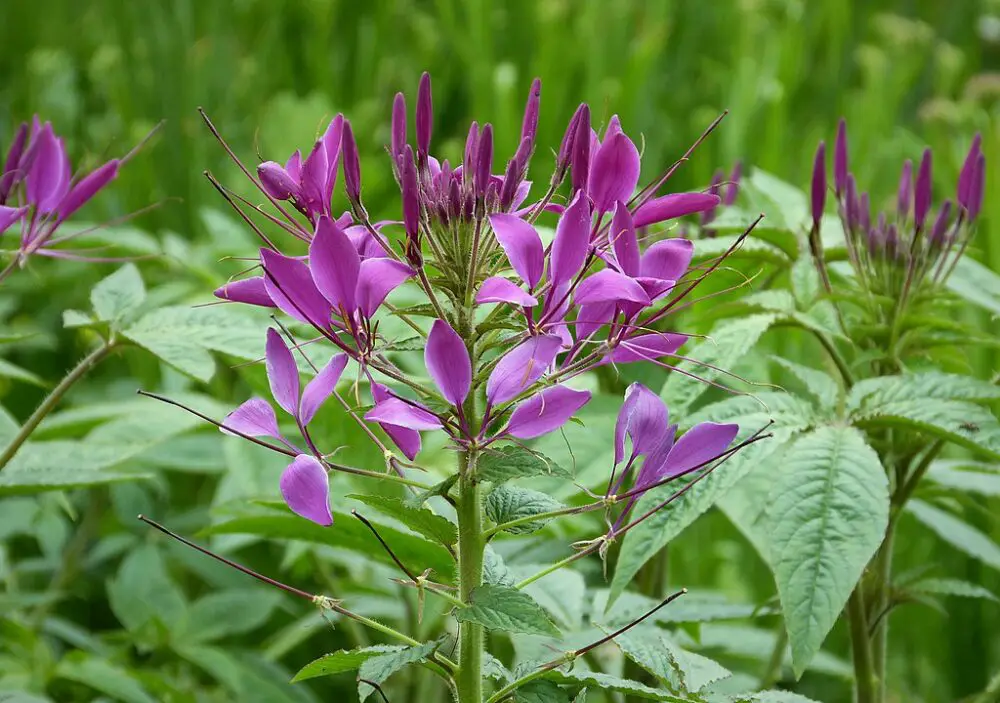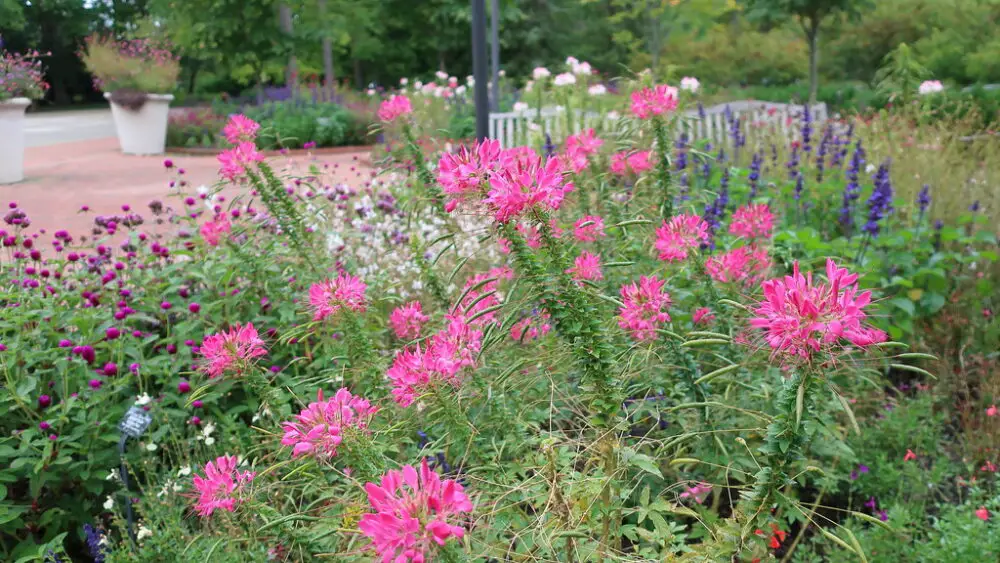Spider flower, or Cleome, is a flowering, drought tolerant annual. The showy plant has prominent white flowers but may also have pink or purple flowers. Spider flowers are edible.
Spider flower plant profile
Additional common names for spider flower include:
- Spider legs
- Grandfather’s whiskers
As a member of the Caper family (Capparaceae), it’s one of 170 species within this genus.
The flower’s delicate petals have a spider-like appearance, as do the seedpods. These features earned Cleome hassleriana its most recognizable common name, spider flower.
What Are You Foraging For Right Now?
We're thrilled to hear your ideas. What would you like to submit today? Feel free to share your thoughts and experiences with us.
The showy plant has prominent white flowers but may also have pink flowers, purple, or flowers in a rose color.
Because it makes beautiful cut flowers and is deer resistant, cleome plants can be frequently found in cottage gardens and landscaping throughout the southern United States.
Part of its desirability is because it not only flowers but is also a tall plant, sometimes 5-6 feet tall.
Regardless of size, spider flowers will bring many types of pollinators to your garden, including bees, butterflies, and hummingbirds.

Why is it called a spider flower?
The aptly named spider flower gets its name from its distinctive appearance.
Attributes lending themselves to this name include:
- Leggy stems
- Feathery petals
- Long stamens
- Elongated seed pods
These all contribute to the unusual and spider-like appearance.
How to identify spider flowers?
In addition to the spidery stamens and elongated seed pods, the spider flower can be distinguished by its sticky, palmate leaves. These leaves produce 5-7 leaflets and emit a fragrance that some equate to the smell of skunk.
Older varieties will have spikes or thorns at the base of each leaf, but newer varieties have been bred to be thornless.
How tall are spider flowers?
Spider flowers are often featured at the back of a garden due to their height. Many of the older varieties can reach heights of 4-5 feet.
Newer hybrids, however, are more compact and denser. These may only grow to 1.5-3 feet.
Understanding your space will help you make the best choice when choosing the right cleome variety for your garden.
Where is spider flower found?
A native to South America and Africa, spider flower prefers warmer climates in loamy and well-drained soil areas.
What is spider flower good for?
Spider flowers make a colorful and elegant addition to any garden or landscape.
They can be planted from seed or transplanted and work well in borders, beds, or large containers that receive full sun.
As these low-maintenance plants mature, they will develop clusters of flowers that can be enjoyed in situ or cut for decoration. Once established, they require little additional watering.
Older varieties of cleome flowers like the Violet Queen, White Queen, Pink Queen, or Rose Queen self-seed will begin to reseed year after year once established.
These are larger varieties and can spread, so adequate spacing must be considered when planting. Newer hybrids, however, are sterile and will not spread similarly.
Because they have a rather long bloom time – early summer until the first frost – they can provide a corner of beauty for a lengthy period of time.
Even during the chilly winter months, the dried flower heads are an attractive point of interest, making deadheading unnecessary.

Are spider flowers edible?
Spider flowers are edible.
They are an important source of nutrition in rural African areas and can be found fresh and for purchase in open air markets in certain parts of the world.
Young shoots, leaves, and flowers can all be consumed and are said to have medicinal as well as culinary value.
In fact, the spider flower contains high amounts of vitamins A and C in addition to helpful antioxidants.
The flavor of spider flowers is slightly bitter, which makes proper preparation important.
Is spider plant a medicinal plant?
There are several noted medicinal uses for spider flowers.
Among them are:
- Prevention of scurvy
- Treatment for scorpion stings and insect bites
- Fever reducer
- Supplement for lactating women
The medical benefits are derived through directly ingesting a tea made from dried leaves or cooking and preparing the leaves and roots.
Cleome seeds are also rich in proteins and contain an oil that can be used topically to reduce itch and inflammation.
How to cook with spider flower
There are numerous ways to cook with spider flower. It can be eaten raw, but the natural bitter flavor makes cooking the preferred method for consumption.
Leaves are often boiled and served as a side dish like spinach or added to soups or stews. They can also be dried and used as a powder and seasoning.
A common preparation for leaves, shoots, and pods is adding them to a pan with milk, oil, and sautéeing. The milk will counteract the bitterness creating tasty and nutritious food.
In some regions of Africa, it’s traditional to give boiled spider flower leaves to new mothers to help them regain strength and improve lactation.
How to plant spider flowers in your garden?
Spider flower is one of the annual plants that has become a favorite for gardeners looking to add color and height to their landscape.
- Seeds can be sowed directly and covered with ¼ inch of moist soil once the danger of frost has passed.
- Germination will happen quickly as long as you keep the soil damp and have planted in a sunny location.
- Spider flower tolerates most garden soils and does not require fertilizer to be its best. In fact, you risk creating overly leggy stems and fewer blooms if fertilizing.
- Once the plant is established, and at full height, it’s fairly self-sufficient, not even requiring staking to keep the long stalks upright.
- Although the spider flowers’ water needs are minimal, a layer of mulch can help preserve the moisture in the soil, keeping your flowers even happier.
When looking for the right variety for your space, you will find a number to choose from.
Some of the more popular varieties of spider flower include:
- Helen Campbell with pure white flowers.
- Linde Armstrong, thornless and boasting mauve, rose, or purple flowers.
- Sparkler bush, providing an elaborate display of pink or white flowers.
There are many others as well to match any taste. Mix and match them for a dramatic array of color and heights.
Lorin is a writer, photographer and nature enthusiast in Sacramento, CA. In addition to gardening, she makes a regular practice of forging for edible plants and flowers. Nature nourishes if you know where to look.

